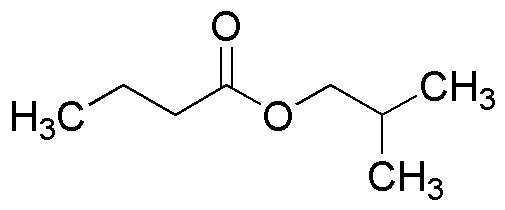Isobutyl butyrate is widely utilized in research focused on
- Flavor and Fragrance Industry: This compound is commonly used as a flavoring agent in food products and as a fragrance component in cosmetics. Its pleasant fruity aroma enhances the sensory experience of various consumer goods.
- Solvent Applications: It serves as an effective solvent in paints, coatings, and adhesives, providing excellent solvency for resins and polymers, which improves product performance and application ease.
- Plasticizers: In the production of plastics, isobutyl butyrate acts as a plasticizer, improving flexibility and durability. This application is crucial in manufacturing flexible PVC products.
- Pharmaceuticals: It is used in the formulation of certain medications, where it can enhance the solubility and bioavailability of active ingredients, making treatments more effective.
- Research and Development: In laboratories, it is often employed as a reagent or intermediate in organic synthesis, facilitating the development of new compounds and materials.
General Information
Properties
Safety and Regulations
Applications
Isobutyl butyrate is widely utilized in research focused on
- Flavor and Fragrance Industry: This compound is commonly used as a flavoring agent in food products and as a fragrance component in cosmetics. Its pleasant fruity aroma enhances the sensory experience of various consumer goods.
- Solvent Applications: It serves as an effective solvent in paints, coatings, and adhesives, providing excellent solvency for resins and polymers, which improves product performance and application ease.
- Plasticizers: In the production of plastics, isobutyl butyrate acts as a plasticizer, improving flexibility and durability. This application is crucial in manufacturing flexible PVC products.
- Pharmaceuticals: It is used in the formulation of certain medications, where it can enhance the solubility and bioavailability of active ingredients, making treatments more effective.
- Research and Development: In laboratories, it is often employed as a reagent or intermediate in organic synthesis, facilitating the development of new compounds and materials.
Documents
Safety Data Sheets (SDS)
The SDS provides comprehensive safety information on handling, storage, and disposal of the product.
Product Specification (PS)
The PS provides a comprehensive breakdown of the product’s properties, including chemical composition, physical state, purity, and storage requirements. It also details acceptable quality ranges and the product's intended applications.
Certificates of Analysis (COA)
Search for Certificates of Analysis (COA) by entering the products Lot Number. Lot and Batch Numbers can be found on a product’s label following the words ‘Lot’ or ‘Batch’.
*Catalog Number
*Lot Number
Certificates Of Origin (COO)
This COO confirms the country where the product was manufactured, and also details the materials and components used in it and whether it is derived from natural, synthetic, or other specific sources. This certificate may be required for customs, trade, and regulatory compliance.
*Catalog Number
*Lot Number
Safety Data Sheets (SDS)
The SDS provides comprehensive safety information on handling, storage, and disposal of the product.
DownloadProduct Specification (PS)
The PS provides a comprehensive breakdown of the product’s properties, including chemical composition, physical state, purity, and storage requirements. It also details acceptable quality ranges and the product's intended applications.
DownloadCertificates of Analysis (COA)
Search for Certificates of Analysis (COA) by entering the products Lot Number. Lot and Batch Numbers can be found on a product’s label following the words ‘Lot’ or ‘Batch’.
*Catalog Number
*Lot Number
Certificates Of Origin (COO)
This COO confirms the country where the product was manufactured, and also details the materials and components used in it and whether it is derived from natural, synthetic, or other specific sources. This certificate may be required for customs, trade, and regulatory compliance.

